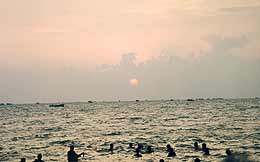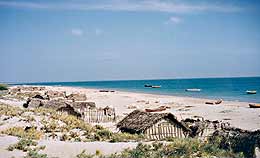|
Rameswaram is a small town on the
eastern side of an island, which is the shape of a conch shell, 55 km
by 12 km. It is one of the four dhamas, or kingdoms of God. The other
three are Badrinath, Puri and Dwarka. It is known as the Varanasi of
the South. Rameswaram is located at the southeastern end of the Indian
Peninsula on the Gulf of Mannar.
(By clicking
on images you will get three times bigger ones in new window)
 |
Sri Ramananthaswami Temple
This is one of the major Lord Siva temples in India. The name
of the deity, Ramananthaswami, indicates that Lord Siva is a great
personality whose worshipable deity is Lord Rama or it can also
mean that even Lord Rama worships Lord Shiva.
This temple was also visited by Shri Chaitanya Mahaprabhu on
His travels.
|
 |
It is said that Rama installed
the Siva-linga in the Ramananthaswami Temple on his return to the
mainland from the island of Lanka, after killing Ravana. Rama wanted
to install a Siva-linga in Rameswaram to absolve himself of the
sin of killing Ravana, who was a Brahmin. Rama sent Hanuman to Mount
Kailash to get the linga. Hanuman was late, so when the auspicious
time for the installation neared, Sita made a Siva-linga out of
sand. This linga was then installed by Rama and is known as the
Rama-linga, because Lord Rama installed it. |
 |
At that time Hanuman came with the Siva-linga from Kailash. He
was disappointed to find a linga already installed. Rama told
Hanuman that he could remove the linga made by Sita and install
the one that he brought in its place. Hanuman took hold of the
linga with his hands and could not move it. He then wrapped his
tail around it and tried to pull the linga out, but it did not
move. The linga is said to still have the marks of Hanuman's tail
on it. To pacify Hanuman, Rama had the linga that he brought,
the Viswa-linga, installed alongside the Rama-linga. He ordered
that puja (worship) be performed first to the Viswa-linga. This
is still being done today.
|
 |
Sita and Ram worshiping Shiva-linga
of Ramananthaswami. On the left side there is Hanuman and Laksman
is on the right. |
 |
On the right side there is
Shiva-linga of Ramananthaswami, on the left there is Sati, his chaste
wife. |
 |
Because non-Hindus are not allowed into the inner sanctum to
see the deities (they can only walk around the rest of the temple),
you can see the lingam at least on paintings.
|
 |
The main entrance.
Parts of the present temple were built in the 12th century. Many
additions have been added over the years. Udayan Sethupathi of
Ramnad expanded the temple in the 15th century and his statue
is found near the southern entrance of the temple. The temple
covers 15 acres. The eastern gopuram is 53m (175 ft) high. This
temple is famous for the 1,220m (3,700 feet) long beautiful corridor
that goes around the temple. There are 22 teerthams (tanks) in
the temple complex in which pilgrims traditionally bathe in before
seeing the deities. Each tank is said to give a different benefit.
Many pilgrims bathe in all 22 tanks before seeing the deity.
|
 |
The sea at Agni Teertham, about 250m from the temple, is a sacred
bathing place, and it is said that if you take bath there all
your sins are washed away. It is traditional to take bath at Agni
Teertham before entering the Ramananthaswami Temple.
|
 |
Rameswaram is really ancient town where one can see things as
this broken gopuram.
|
 |
Rama-tirtha
is a water tank where Sri Ramacandra is said to be bathing. Kodi-tirtha
is a spring created by Ram's arrow.
|
 |
Ramacandra's temple near Rama-tirtha. |
 |
Nearby we can find many places
connected to Rama's pastimes and events depicted in Ramayana. There
is a temple near the bridge that you cross to enter Rameswaram where
there is a floating rock. When Lord Rama went to Lanka with the
monkey army, they crossed the ocean on a bridge of floating rocks.
The floating rock in this temple proves that floating rocks exist.
|
 |
Jay and Vijay near temple
entrance. |
 |
Deities of Sita, Ram, Laksman and Hanuman at Rama-tirtha.
|
 |
Arati for Nrsimha Swami. |
 |
Kothandaramasvami
Temple
It is located about 8 km from Rameswaram, or about 6 km from the
southernmost tip of the island going toward Dhanushkodi. |
 |
There are deities of Rama, Sita, Laksman, Hanuman and Vibhishana
bowing to Rama here. It is said that Vibhishana, Ravana's brother,
surrendered to Lord Rama at this place. A series of paintings
inside the temple tells the pastime.
|
 |
In 1964 a cyclone wiped out everything in the surrounding area.
The only thing left standing was this temple.
It is said that Hanuman made his great leap to Lanka from place
called Gandhamadhana Parvatham with two-story temple is on a small
hilltop, about 2.5 km northwest of the Ramananthaswami Temple.
|
 |
Dhanushkodi
Dhanushkodi is about 20 km southeast of Rameswaram. This is the
place where the Bay of Bengal meets the Indian Ocean. It is said
that Lord Rama, an incarnation of Lord Vishnu, bathed at Dhanushkodi. |
 |
It is said that here Lord Rama destroyed a small bridge with
his bow at the request of Vibhishana, the younger brother of Ravana.
|
 |
Pilgrims are supposed to bathe in the small lagoon here called
Ratnakara. This is a place to offer sraddha to the ancestors.
It is said to be especially auspicious to bathe here in May. It
is a nice place to visit.
|
 |
Dhanushkodi is a holy place "in the middle of nowhere".
One is surrounded only by sand and water.
|
 |
No trees are growing there
and to sit in shade seems to be a luxury. |
 |
Nowadays there are no so many
fish as it used to be. Local fisherman told me that 20 years ago
his nets were so heavy that he couldn't even lift them... |
 |
...and this old grandma confirmed
it. |
 |
Pamban is fisherman's village
on the other side of the island. |
 |
 |
 |
Fisherman's family. |
 |
On the beach one can see disintegrating
British Forth that is supposedly few hundred years old. The ocean
gradually devours it. |
 |
Small Sati is a daughter of
fisherman living with her grandma 15 km from Dhanushkodi. |
 |
She called me "uncle"... |
 |
...and really liked my watches, which I gave her for playing. |
|
































